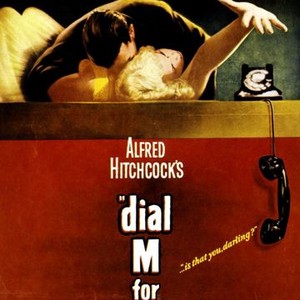Introduction:
Released in 1954, “Dial M for Murder” stands as a gripping testament to Alfred Hitchcock’s mastery in the thriller genre. Based on the play by Frederick Knott, this cinematic adaptation weaves a tale of crime, deception, and suspense. In this extensive review, we will delve into the film’s narrative intricacies, Hitchcock’s directorial finesse, the brilliant performances of the cast, and the enduring impact of “Dial M for Murder” as a classic within the crime and thriller genres.
I. Hitchcock’s Craftsmanship:
1.1 Hitchcock’s Signature Style:
- “Dial M for Murder” showcases Hitchcock’s trademark directorial flair, with every frame meticulously composed for maximum tension and visual impact.
- The film’s intricate plot and character dynamics are expertly orchestrated, providing a cinematic experience that transcends its stage origins.
1.2 Stage-to-Screen Adaptation:
- Originally a successful stage play, Hitchcock’s adaptation retains the play’s intensity while leveraging the cinematic medium to enhance suspense.
- The confined setting becomes a psychological battleground, allowing Hitchcock to explore the intricacies of human behavior.
II. The Plot Unraveled:
2.1 Tony Wendice’s Devious Plot:
- The film centers on Tony Wendice, played by Ray Milland, a former tennis pro who hatches a meticulous plan to murder his wealthy wife, Margot, played by Grace Kelly.
- The plot unfolds as a carefully orchestrated chess game of deception, with Tony manipulating events to frame another man for the crime.
2.2 The Perfect Crime:
- Hitchcock expertly guides the audience through the planning and execution of the seemingly perfect crime.
- The tension builds as unforeseen complications arise, transforming the narrative into a suspenseful exploration of human desperation and cunning.
III. The Cast’s Compelling Performances:
3.1 Ray Milland as Tony Wendice:
- Ray Milland delivers a compelling performance as the calculating and sinister Tony Wendice.
- Milland’s ability to portray the character’s charm and malevolence adds depth to the film, making Tony a memorable antagonist.
3.2 Grace Kelly’s Graceful Portrayal:
- Grace Kelly, in her second collaboration with Hitchcock, brings sophistication and vulnerability to the role of Margot Wendice.
- Kelly’s performance captures the emotional nuances of a woman caught in a web of deceit and danger.
3.3 John Williams as Chief Inspector Hubbard:
- John Williams, in the role of Chief Inspector Hubbard, provides a steady and determined presence as the investigator tasked with unraveling the truth.
- Williams’ performance adds a layer of authenticity to the film’s procedural elements.
IV. Hitchcockian Themes Explored:
4.1 The Perfect Crime and Its Consequences:
- “Dial M for Murder” delves into Hitchcock’s recurring theme of the “perfect crime” and the unforeseen consequences that unfold.
- The film challenges the audience’s allegiance as they witness the plan’s meticulous execution and the unraveling of Tony’s carefully laid schemes.
4.2 Tension in Confined Spaces:
- Hitchcock excels in creating tension within confined spaces, with much of the film taking place in the Wendice apartment.
- The director’s use of space and camera angles intensifies the suspense, turning the familiar setting into a claustrophobic battleground.
V. Hitchcock’s Cinematic Techniques:
5.1 Innovative Camera Work:
- Hitchcock employs innovative camera techniques to heighten the suspense, using angles and perspectives to manipulate the audience’s perception.
- The director’s use of close-ups and point-of-view shots enhances the psychological impact of key moments.
5.2 The Telephone as a Prop:
- The telephone becomes a crucial prop in the film, serving as a conduit for communication and manipulation.
- Hitchcock skillfully uses the telephone as both a plot device and a symbol of the characters’ interconnected fates.
VI. Hitchcock’s Approach to Adaptation:
6.1 Faithful to the Source Material:
- While “Dial M for Murder” is an adaptation of Frederick Knott’s play, Hitchcock maintains the essence of the stage production while leveraging the cinematic medium.
- The director’s understanding of the differences between stage and screen allows for a compelling and visually engaging adaptation.
6.2 Cinematic Enhancements:
- Hitchcock introduces cinematic elements, such as dynamic camera movements and close-ups, to enhance the storytelling beyond the limitations of the stage.
- The film’s visual language adds a layer of complexity to the narrative, creating an immersive cinematic experience.
VII. Critical Acclaim and Awards:
7.1 Critical Praise:
- “Dial M for Murder” received critical acclaim for its suspenseful narrative, Hitchcock’s direction, and the standout performances of the cast.
- Critics recognized the film’s ability to sustain tension and deliver a gripping crime thriller.
7.2 Box Office Success:
- The film was a commercial success upon its release, further solidifying Hitchcock’s reputation as a director capable of delivering both critical and financial triumphs.
VIII. Cultural Impact and Legacy:
8.1 Hitchcock’s Lasting Influence:
- “Dial M for Murder” remains a testament to Hitchcock’s enduring influence on the crime thriller genre.
- The film’s exploration of deception, crime, and psychological tension has left an indelible mark on subsequent filmmakers.
8.2 Home Viewing and Revival:
- “Dial M for Murder” has experienced revivals through home viewing, retaining its popularity with audiences seeking Hitchcock’s classic brand of suspense.
- The film’s availability on various platforms ensures its continued appreciation by new generations of viewers.
IX. Conclusion: A Cinematic Chess Match
In conclusion, “Dial M for Murder” stands as a cinematic chess match, where every move is calculated, and suspense builds with each strategic decision. Alfred Hitchcock’s directorial finesse, coupled with the stellar performances of the cast, transforms this crime thriller into a timeless classic. The film’s exploration of the perfect crime, its consequences, and the tension within confined spaces showcase Hitchcock’s ability to captivate audiences. “Dial M for Murder” remains a testament to the enduring allure of Hitchcock’s storytelling, inviting viewers into a world of intricate plots, unexpected twists, and psychological intrigue. As we revisit this Hitchcockian masterpiece, we are reminded that, much like a well-played game of chess, “Dial M for Murder” continues to engage and challenge audiences, leaving an indelible mark on the landscape of classic crime thrillers.
